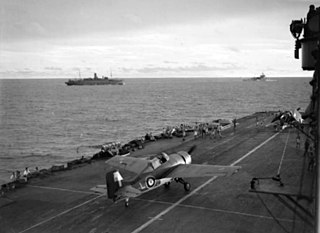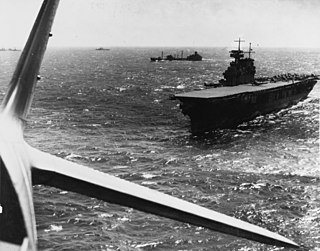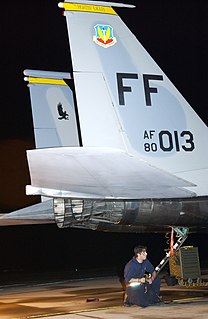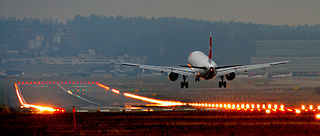
An aircraft carrier is a warship that serves as a seagoing airbase, equipped with a full-length flight deck and facilities for carrying, arming, deploying, and recovering aircraft. Typically, it is the capital ship of a fleet, as it allows a naval force to project air power worldwide without depending on local bases for staging aircraft operations. Carriers have evolved since their inception in the early twentieth century from wooden vessels used to deploy balloons to nuclear-powered warships that carry numerous fighters, strike aircraft, helicopters, and other types of aircraft. While heavier aircraft such as fixed-wing gunships and bombers have been launched from aircraft carriers, it is currently not possible to land them. By its diplomatic and tactical power, its mobility, its autonomy and the variety of its means, the aircraft carrier is often the centerpiece of modern combat fleets. Tactically or even strategically, it replaced the battleship in the role of flagship of a fleet. One of its great advantages is that, by sailing in international waters, it does not interfere with any territorial sovereignty and thus obviates the need for overflight authorizations from third party countries, reduce the times and transit distances of aircraft and therefore significantly increase the time of availability on the combat zone.

USS George H.W. Bush (CVN-77) is the tenth and final Nimitz-class supercarrier of the United States Navy. She is named for the 41st President of the United States and former Director of Central Intelligence George H. W. Bush, who was a naval aviator during World War II. Bush's callsign is Avenger, after the TBM Avenger aircraft flown by then-Lieutenant George H.W. Bush in World War II. Construction began in 2003 at the Northrop Grumman Newport News shipyard's Dry Dock 12, the largest in the western hemisphere. She was completed in 2009 at a cost of $6.2 billion and her home port is Naval Station Norfolk, Virginia.

The flight deck of an aircraft carrier is the surface from which its aircraft take off and land, essentially a miniature airfield at sea. On smaller naval ships which do not have aviation as a primary mission, the landing area for helicopters and other VTOL aircraft is also referred to as the flight deck. The official U.S. Navy term for these vessels is "air-capable ships".

The North American FJ-2 and FJ-3 Fury are a series of swept-wing carrier-capable fighters for the United States Navy and Marine Corps. The FJ-2 resulted from an effort to navalise the United States Air Force's F-86 Sabre. These aircraft featured folding wings, and a longer nose landing strut designed to increase angle of attack upon launch and to accommodate a longer oleo to absorb the shock of hard landings on an aircraft carrier deck.

The Forrestal-class aircraft carriers were four aircraft carriers designed and built for the United States Navy in the 1950s. It was the first class of supercarriers, combining high tonnage, deck-edge elevators and an angled deck. The first ship was commissioned in 1955, the last decommissioned in 1998.

The Ryan FR Fireball was a mixed-power fighter aircraft designed by Ryan Aeronautical for the United States Navy during World War II. It was the Navy's first aircraft with a jet engine. Only 66 aircraft were built before Japan surrendered in August 1945. The FR-1 Fireball equipped a single squadron before the war's end, but did not see combat. The aircraft ultimately proved to lack the structural strength required for operations aboard aircraft carriers and was withdrawn in mid-1947.

Naval aviation is the application of military air power by navies, whether from warships that embark aircraft, or land bases.

A precision approach path indicator (PAPI) is a visual aid that provides guidance information to help a pilot acquire and maintain the correct approach to an airport or an aerodrome. It is generally located on the left-hand side of the runway approximately 300 meters beyond the landing threshold of the runway.

Kara Spears Hultgreen was a lieutenant and naval aviator in the United States Navy and the first female carrier-based fighter pilot in the U.S. Navy. She died just months after she was certified for combat, when she crashed her F-14 Tomcat into the sea on final approach to USS Abraham Lincoln.

USS Wolverine (IX-64) was a training ship used by the United States Navy during World War II. She was originally named Seeandbee and was built as a Great Lakes luxury side-wheel steamer cruise ship for the Cleveland and Buffalo Transit Company. Seeandbee was launched on 9 November 1912 and was normally used on the Cleveland, Ohio to Buffalo, New York route with special cruises to other ports. After the original owners went bankrupt in 1939 Seeandbee was purchased by Chicago-based C & B Transit Company and continued operating until 1941.

Naval Air Station Oceana or NAS Oceana is a military airport located in Virginia Beach, Virginia, and is a United States Navy master jet base. It is also known as Apollo Soucek Field, named after Lieutenant Apollo Soucek, a Navy Test Pilot who set the global altitude record in 1930 by flying a Curtiss "Hawk" biplane to an altitude of 43,166 feet. NAS Oceana is the only Master Jet Base on the East Coast.

NAeSão Paulo was a Clemenceau-class aircraft carrier in service with the Brazilian Navy. São Paulo was first commissioned in 1963 by the French Navy as Foch and was transferred in 2000 to Brazil, where she became the new flagship of the Brazilian Navy. IHS Jane's reported that during its career with the Brazilian Navy, São Paulo suffered from serviceability issues and never managed to operate for more than three months at a time without the need for repairs and maintenance. On 14 February 2017, the navy announced the ship's demobilisation and subsequent decommissioning.

John "Jack" Lawrence Finley was a United States Navy aviator and was selected as an astronaut.

In naval aviation, a bolter occurs when an aircraft attempting an arrested landing on the flight deck of an aircraft carrier touches down, but fails to catch an arrestor cable and come to a stop. Bolter aircraft accelerate at full throttle and become airborne in order to go-around and re-attempt the landing.

An amphibious assault ship is a type of amphibious warfare ship employed to land and support ground forces on enemy territory by an amphibious assault. The design evolved from aircraft carriers converted for use as helicopter carriers. Modern ships support amphibious landing craft, with most designs including a well deck. Coming full circle, some amphibious assault ships also support V/STOL fixed-wing aircraft, now having a secondary role as aircraft carriers.

Modern United States Navy aircraft carrier air operations include the operation of fixed-wing and rotary aircraft on and around an aircraft carrier for performance of combat or noncombat missions. Modern United States Navy aircraft carrier flight operations are highly evolved, based on experiences dating back to 1922 with USS Langley.

The Naval Air Training and Operating Procedures Standardization (NATOPS) program prescribes general flight and operating instructions and procedures applicable to the operation of all U.S. naval aircraft and related activities. The program issues policy and procedural guidance of the Chief of Naval Operations (CNO) and the Commandant of the Marine Corps (CMC) that is applicable to all U.S. Navy and U.S. Marine Corps aviation personnel.

Strike Fighter Squadron 204 (VFA-204), also known as the "River Rattlers", is a U.S. Navy Reserve strike fighter squadron flying the F/A-18A+ Hornet. The squadron is based out of Naval Air Station Joint Reserve Base New Orleans and is part of the United States Navy Reserve's Tactical Support Wing. Their radio callsign is River and their tail code is AF.

Aircraft carriers are warships that evolved from balloon-carrying wooden vessels into nuclear-powered vessels carrying scores of fixed- and rotary-wing aircraft. Since their introduction they have allowed naval forces to project air power great distances without having to depend on local bases for staging aircraft operations.







































